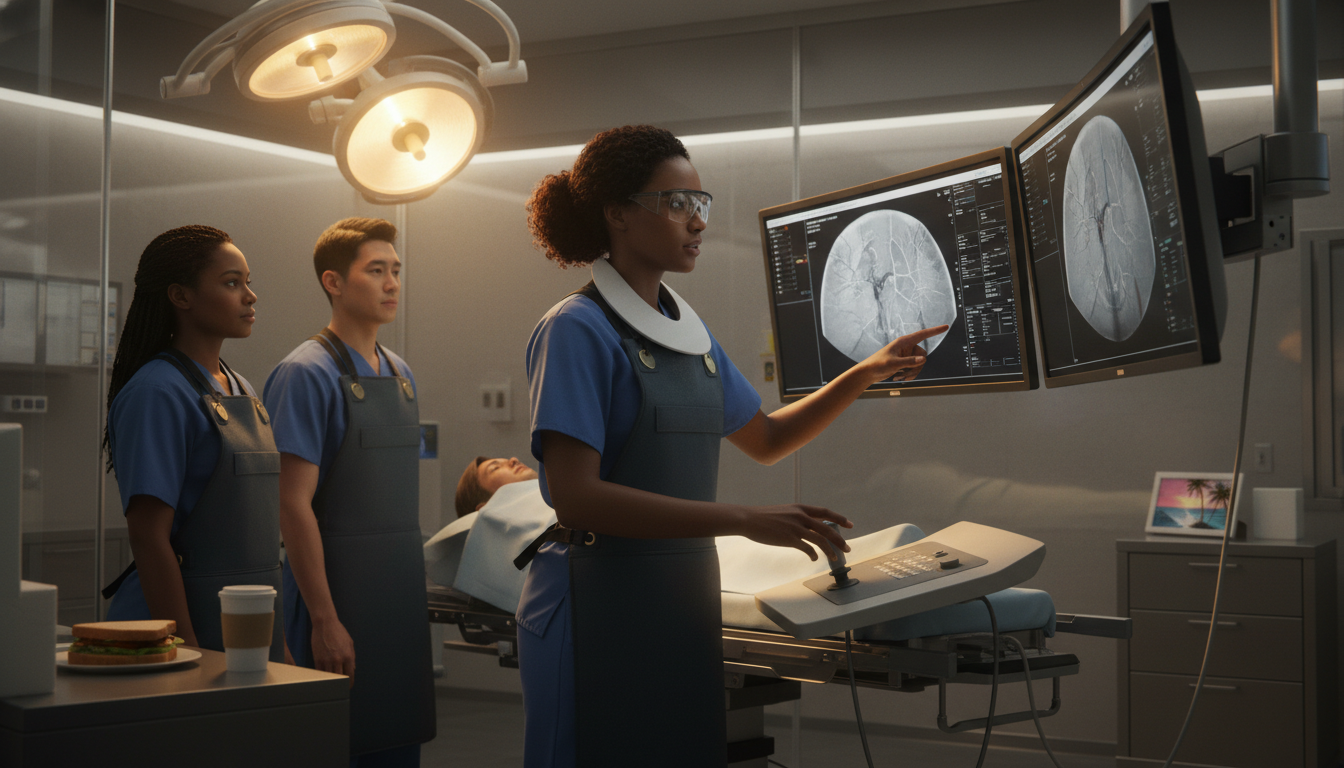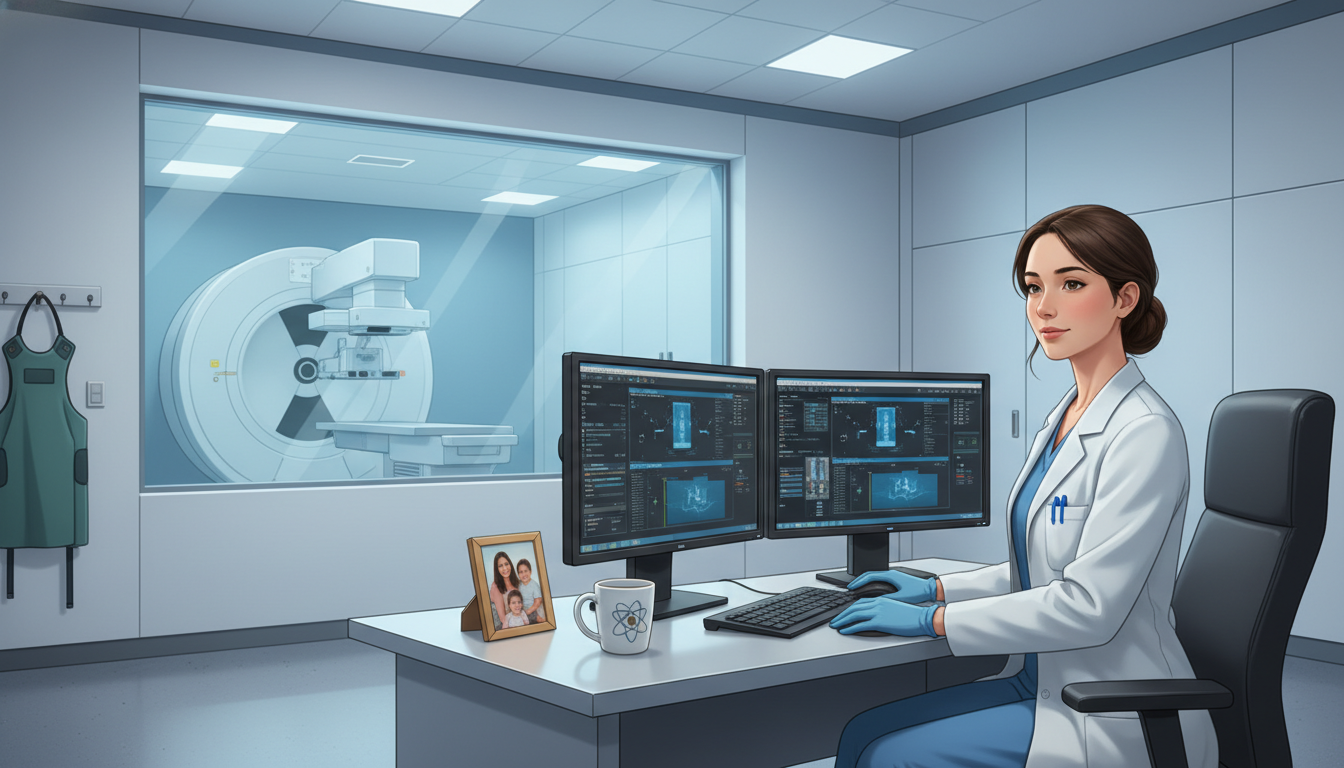Why Radiology Offers the Best Work-Life Balance in Medicine

Why Radiology Is Known for Attractive Work Hours and Strong Work-Life Balance
Radiology consistently appears on lists of the most lifestyle-friendly medical specialties. While it is intellectually demanding and central to modern medicine, many radiologists enjoy more predictable schedules and greater flexibility than peers in procedural or shift-based fields. For medical students and residents weighing career options, understanding how radiology work hours actually look in practice is critical.
This article explores how the structure of radiology work supports work-life balance, what typical schedules look like across practice settings, how Tele-Radiology is changing the game, and what real radiologists say about their day-to-day lives. We will compare radiology with other medical specialties and offer practical career advice for trainees considering this path.
Core Role of the Radiologist: What the Job Really Involves
Before analyzing hours and lifestyle, it’s important to understand what radiologists actually do and how that shapes their schedules.
Radiologists are physicians trained to diagnose and sometimes treat disease using medical imaging. Core modalities include:
- X-rays (radiography)
- Computed Tomography (CT)
- Magnetic Resonance Imaging (MRI)
- Ultrasound
- Positron Emission Tomography (PET)
- Fluoroscopy and image-guided procedures
Key Responsibilities
- Image Interpretation: The primary responsibility is reading and interpreting imaging studies and generating clear, actionable reports for referring clinicians.
- Clinical Consultation: Radiologists frequently discuss findings with surgeons, internists, emergency physicians, oncologists, and others to refine diagnoses and guide management.
- Procedures (for some subspecialties): Interventional radiologists and some body or neuro radiologists perform minimally invasive, image-guided procedures (e.g., biopsies, drain placements, angiography).
- Quality and Safety: Protocoling studies, optimizing imaging techniques, ensuring radiation safety, and supervising technologists.
- Education and Research (in academic settings): Teaching residents and medical students, engaging in clinical research, and participating in multidisciplinary conferences (e.g., tumor boards).
Because much of diagnostic radiology is non-emergent and scheduled, the workflow lends itself to more regular hours compared to hospital-based specialties that are dominated by emergencies, admissions, and unpredictable inpatient demands.
How Radiology Work Hours Are Structured
Radiology’s reputation for lifestyle friendliness is not a myth, but it is nuanced. Schedules vary widely by subspecialty, practice type, and region. Still, several themes consistently support better work-life balance compared with many other medical specialties.

1. Regular, Predictable Daytime Hours in Many Settings
In a typical diagnostic radiology role (especially in outpatient centers or community groups):
- Standard workweek: Often Monday through Friday
- Typical hours: Commonly around 8 AM–5 PM or 9 AM–5 PM
- Evenings/weekends: Often limited or scheduled rather than continuous
Because imaging is largely scheduled during regular business hours, radiologists frequently enjoy:
- Consistent daily start and end times
- Fewer last-minute “add-ons” than surgeons or internists managing inpatients
- More control over personal time for family, hobbies, and non-clinical projects
This predictable and largely office-hour-based schedule makes radiology particularly attractive for those who value routine and planning.
2. On-Call and Night Coverage: Real but Typically More Structured
Radiologists do take call, especially in hospital-based practices, but the nature of this call is different from being a surgeon or emergency physician.
Diagnostic Radiology Call
- Focuses on interpreting emergency and inpatient imaging (e.g., trauma CTs, stroke imaging, acute abdominal CT).
- Often provided through:
- In-house evening shifts
- Night float systems
- Tele-Radiology services covering overnight studies
Compared to procedural fields:
- Call is less physically exhausting—no running to the OR in the middle of the night.
- Work can often be done from a computer (sometimes from home), which reduces commuting burden and physical disruption.
Interventional Radiology (IR) Call
- IR, a more procedural subspecialty, typically has more robust call due to emergent procedures:
- Bleeding control, stroke thrombectomy (in some systems), drain placements, acute limb ischemia, etc.
- Call is more similar to surgical fields, but:
- Often shared among a group, distributing the burden.
- Still generally allows for some lifestyle planning compared with many traditional surgical specialties.
For many radiologists, call is:
- Predictable in frequency (e.g., 1 night per week, 1 weekend per month)
- Sometimes compensated with post-call time off, evening differentials, or additional salary
3. Tele-Radiology: Flexibility and Remote Work Options
Tele-Radiology has fundamentally changed how radiologists can structure their careers and work hours.
What Tele-Radiology Offers
- Ability to interpret imaging studies remotely from home or off-site workstations
- Coverage for:
- Overnight and weekend emergency studies
- Rural or underserved hospitals lacking on-site radiologists
- Overflow volumes for busy practices
Lifestyle Advantages
- Eliminates commuting time for some or all shifts
- Allows radiologists to:
- Work non-traditional hours if desired (e.g., nights, early mornings) in exchange for more daytime free hours
- Live in a different city—or even state—from the hospitals they serve
- Can be particularly appealing for:
- Parents seeking to align work hours with childcare schedules
- Radiologists who prefer remote work and geographic flexibility
- Those who want to increase income with extra reading shifts from home
However, Tele-Radiology can be high-volume and intense, especially for emergency work. Balancing productivity expectations with lifestyle goals is key.
4. Practice Setting Shapes Lifestyle
Your work environment dramatically influences your schedule and autonomy.
Academic Radiology
- Hours: Often similar to business hours, with added responsibilities in:
- Teaching
- Research
- Conferences and tumor boards
- Call: Usually shared among faculty and residents/fellows, with structured schedules
- Lifestyle Pros:
- Intellectually rich environment
- Predictable clinic/conference days
- Opportunities for flexible academic time and remote work, depending on institution
- Cons:
- Lower compensation than many private practices (on average)
- Additional meetings and administrative tasks
Private Practice / Group Practice
- Hours: Often standard business hours or slightly extended (e.g., 7 AM–4 PM, 8 AM–6 PM)
- Call: Varies widely:
- Some groups use Tele-Radiology for nights and offer minimal call to daytime radiologists
- Others expect rotating night or weekend coverage
- Lifestyle Pros:
- Potentially higher compensation
- Some control over schedule through partnership negotiations
- Ability to shape one’s role (e.g., more days, fewer nights; or vice versa)
- Cons:
- Productivity pressures
- Business-related responsibilities for partners
Outpatient Imaging Centers
- Hours: Heavily skewed to daytime, weekday work, with minimal nights or weekends
- Work: Mostly scheduled outpatient imaging (MRI, CT, US, mammography)
- Lifestyle Pros:
- Very regular, clinic-like schedule
- Rarely called in for emergencies
- Cons:
- Less variety in cases compared with tertiary hospitals
- Sometimes lower pay than high-intensity hospital work, depending on region
Real-World Examples: How Radiologists Actually Structure Their Days
While radiology is not “easy,” it does offer many physicians a sustainable, balanced career. These anonymized scenarios illustrate different lifestyle models.
Example 1: Diagnostic Radiologist in a Community Hospital
- Schedule: Monday–Friday, 8 AM–5 PM
- Call: 1 weekday evening every 2 weeks, 1 weekend day every 6–8 weeks
- Practice: Mix of CT, MRI, X-ray, ultrasound, mammography
- Lifestyle:
- Home by 5:30 PM most days
- Minimal unplanned late nights
- Able to coach children’s sports and maintain hobbies (e.g., photography, travel)
This model resembles what many envision when they think of a “lifestyle-friendly” specialty: a stable income, interesting work, and reasonable boundaries between work and home.
Example 2: Interventional Radiologist in a Tertiary Care Center
- Schedule: Roughly 7:30 AM–5:30 PM, with procedure-heavy days
- Call: 1 in 4 weeks, including nights and some weekends for emergent procedures
- Practice: Angiography, embolizations, drain placements, complex interventions
- Lifestyle:
- A mix of structured elective procedures and unpredictable emergencies
- Higher stress and call burden than diagnostic colleagues
- Very rewarding for those who enjoy hands-on impact, but less “9-to-5”
Compared to general surgery, however, this IR may still have:
- Fewer prolonged overnight OR cases
- More control over elective case scheduling
Example 3: Tele-Radiologist Working Primarily from Home
- Schedule: 7 PM–3 AM shifts, four nights per week; weekdays off
- Call: None in the traditional sense—scheduled shifts replace “call”
- Practice: High-volume emergency CTs, MRIs, and X-rays from multiple hospitals
- Lifestyle:
- Nights are intense but contained
- Daytime free for childcare, hobbies, or second careers
- No commuting, flexible geographic location
For some physicians, this model is ideal; for others, night-heavy work is not sustainable. The key is the ability to choose a schedule that fits personal priorities, which is a major strength of radiology as a specialty.
Radiology vs Other Medical Specialties: Lifestyle Comparison
Radiology is frequently listed alongside dermatology, ophthalmology, and pathology as one of the more lifestyle-friendly medical specialties. Below is a high-level comparison of how radiology’s work hours stack up against other fields.
| Specialty | Typical Schedule | On-Call Duties | Lifestyle Notes |
|---|---|---|---|
| Radiology | Mostly weekdays, 8–5 in many settings | Moderate; varies by practice and subspecialty | Often predictable; Tele-Radiology adds flexibility |
| Surgery | Early starts, long and unpredictable days | High; frequent overnight and weekend calls | Physically and time-intensive; frequent emergencies |
| Internal Medicine (Hospitalist) | 7-on/7-off or varying shifts | Moderate to high, especially in-patient | Shift work; nights and weekends common |
| Emergency Medicine | 8–12 hour shifts, days/nights/weekends | Core nature of job | Intense but defined shifts; no call, but circadian strain |
| Family Medicine | Mostly weekdays, office hours | Moderate; outpatient call or inpatient rounding | Good lifestyle, but more paperwork and continuity demands |
| Anesthesiology | Early mornings, variable end times | OR-based call, variable by hospital | Can be lifestyle-friendly but varies widely |
Radiology stands out for its:
- High degree of scheduling predictability (in many practices)
- Substantial remote-work options
- Flexibility across practice types (academic, private, Tele-Radiology, outpatient)
These features collectively make radiology one of the most lifestyle-friendly medical specialties, especially for those who prioritize Work-Life Balance without sacrificing intellectual challenge.
Career Advice: How to Optimize Work-Life Balance in Radiology
As with any field, your lifestyle in Radiology will depend heavily on choices you make during and after training. Here are practical strategies and considerations.
1. Choose Subspecialty Wisely
Different radiology subspecialties offer different lifestyle profiles:
- More predictable, primarily daytime subspecialties:
- Neuroradiology (varies by practice)
- Musculoskeletal radiology
- Breast imaging / women’s imaging
- Body imaging in outpatient-focused practices
- Procedural and call-heavy subspecialties:
- Interventional Radiology
- Neurointerventional Radiology
Ask yourself:
- Do you enjoy procedures and direct patient contact enough to accept more call?
- Or do you prefer image interpretation and a more predictable schedule?
2. Research Practice Models During Job Search
When evaluating jobs, dig deeply into:
- Average weekly hours and start/stop times
- Call structure: frequency, type (in-house vs Tele-Radiology), weekend expectations
- Tele-Radiology use: Are nights outsourced or in-house?
- Productivity expectations: RVU targets, minimum study volumes
- Options for part-time or flexible scheduling
Ask senior residents and attendings about reputation for burnout vs balance in specific groups or regions.
3. Leverage Tele-Radiology Strategically
Tele-Radiology can be used:
- As a primary career (full-time remote)
- As a supplemental income stream (extra shifts)
- As a temporary phase (e.g., during early parenthood or relocation)
When considering Tele-Radiology roles, pay attention to:
- Shift timing (nights vs days)
- Study volume expectations
- Support resources (IT, second reads, subspecialty backup)
4. Protect Boundaries and Prevent Burnout
Even in a lifestyle-friendly specialty, burnout is possible if boundaries erode.
- Set clear expectations with your group about availability outside scheduled hours.
- Learn efficient reading strategies to manage high volume without sacrificing quality.
- Maintain non-medical interests and connections to life outside the reading room.
- Use vacation time fully; radiology groups often have generous PTO, but many physicians underutilize it.

FAQs: Radiology Work Hours, Lifestyle, and Career Planning
1. Do radiologists work weekends and nights?
Yes, some radiologists do work weekends and nights—but how often depends heavily on practice type and subspecialty.
- Hospital-based and emergency imaging: Often require evening, night, and weekend coverage. This may be covered by in-house radiologists, night float systems, or Tele-Radiology.
- Outpatient imaging centers: Typically focus on weekday daytime hours, with minimal evening or weekend requirements.
- Interventional radiologists: More frequently have night and weekend call due to emergent procedures.
For many diagnostic radiologists, weekend and night work is occasional and scheduled, not an unpredictable constant.
2. Can radiologists really work from home?
Yes. Tele-Radiology has made remote work a standard part of modern radiology.
Many radiologists:
- Work fully remote for Tele-Radiology groups
- Have hybrid roles, reading part of the week from home and part on-site
- Cover night shifts or call from home workstations
This flexibility is a major advantage of radiology over many other medical specialties and is a key contributor to its strong Work-Life Balance.
3. How many hours per week do radiologists typically work?
Most full-time radiologists work roughly 40–60 hours per week, depending on:
- Practice type (academic vs private vs Tele-Radiology)
- Call responsibilities
- Productivity expectations
- Subspecialty
In comparison to other physician roles, radiology tends to cluster closer to the 40–50 hour range in many practices, especially outpatient or Tele-Radiology models, though high-intensity groups may push higher.
4. Is radiology still a good choice given AI and automation?
Despite growth in artificial intelligence, radiology remains a high-demand, stable specialty:
- AI currently functions primarily as a decision-support tool, not a replacement for radiologists.
- Imaging volumes continue to grow as populations age and advanced imaging becomes standard in clinical pathways.
- Radiologists increasingly focus on:
- Complex interpretation
- Integrating multimodal data
- Communicating nuanced findings to clinical teams
From a career advice standpoint, radiology remains a strong option for those who want intellectually engaging work and a lifestyle-compatible specialty.
5. Is radiology a good fit if I prioritize work-life balance as a physician?
For many physicians, yes. Radiology is consistently considered one of the most lifestyle-friendly medical specialties, especially for those who value:
- Predictable, mostly daytime hours (depending on role)
- Flexibility to work remotely
- The ability to choose among diverse practice models
- A balance of high compensation, intellectual complexity, and manageable call
However, it’s important to recognize that radiology is also fast-paced and cognitively demanding, and some niches (like Interventional Radiology or high-volume Tele-Radiology) can be intense. Aligning your specific role and subspecialty with your personal priorities is critical.
Radiology occupies a unique position in medicine: it is at the technological and diagnostic core of modern care, yet it offers many physicians a structured, flexible, and sustainable life outside the hospital. For students and residents seeking a specialty with robust Work-Life Balance, diverse practice options, and opportunities for Tele-Radiology and remote work, radiology deserves serious consideration as a long-term, fulfilling career path.

SmartPick - Residency Selection Made Smarter
Take the guesswork out of residency applications with data-driven precision.
Finding the right residency programs is challenging, but SmartPick makes it effortless. Our AI-driven algorithm analyzes your profile, scores, and preferences to curate the best programs for you. No more wasted applications—get a personalized, optimized list that maximizes your chances of matching. Make every choice count with SmartPick!
* 100% free to try. No credit card or account creation required.



















